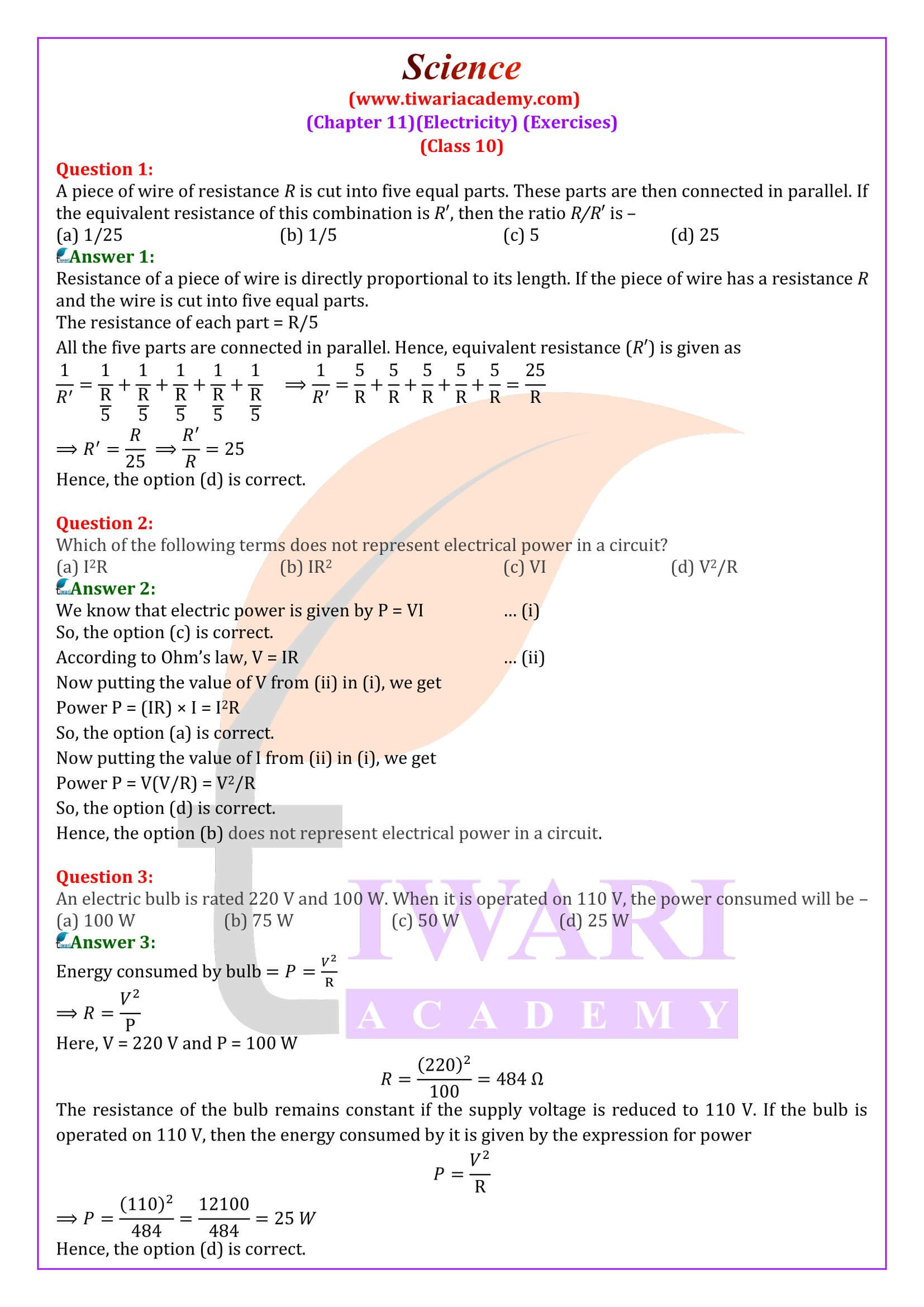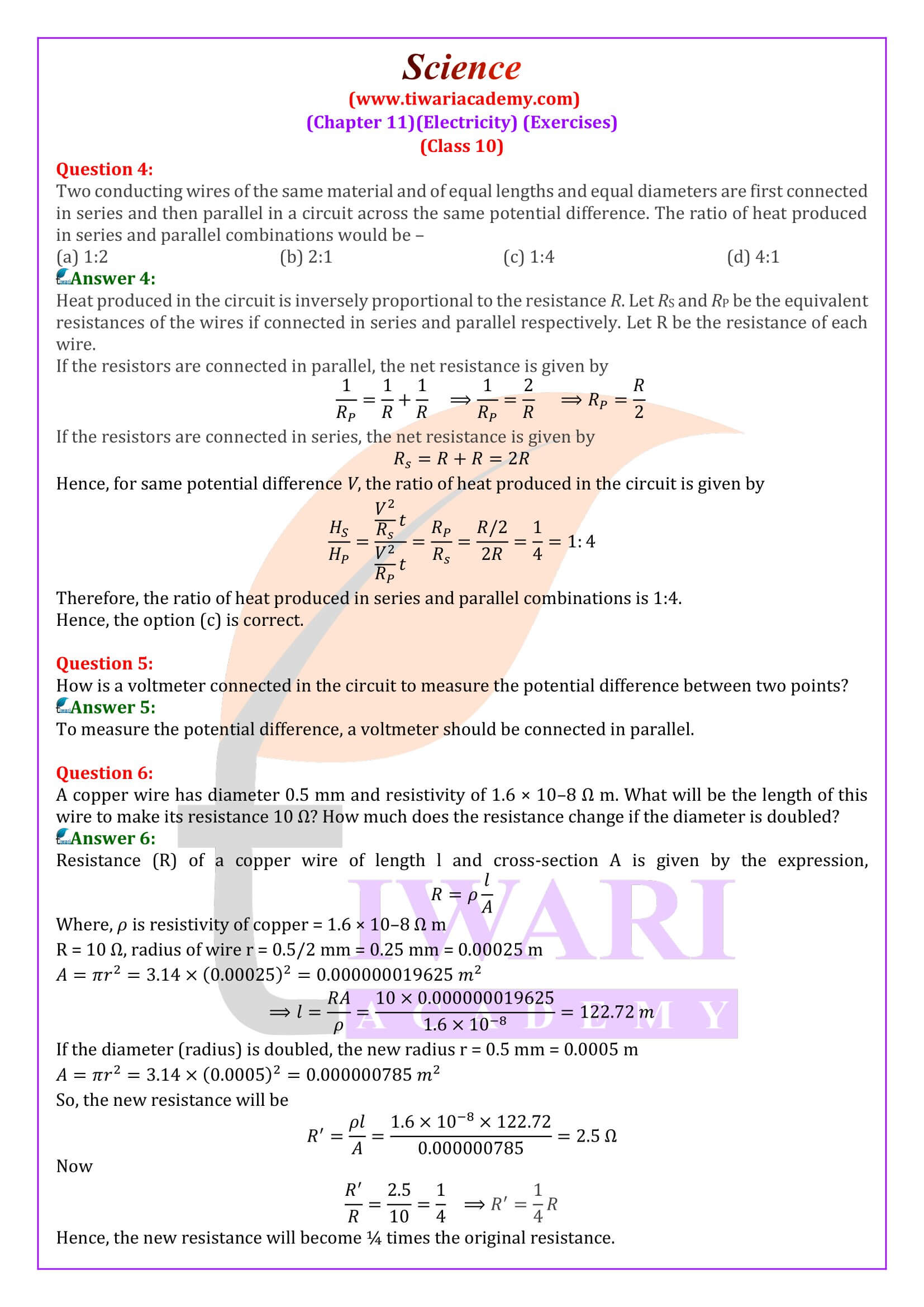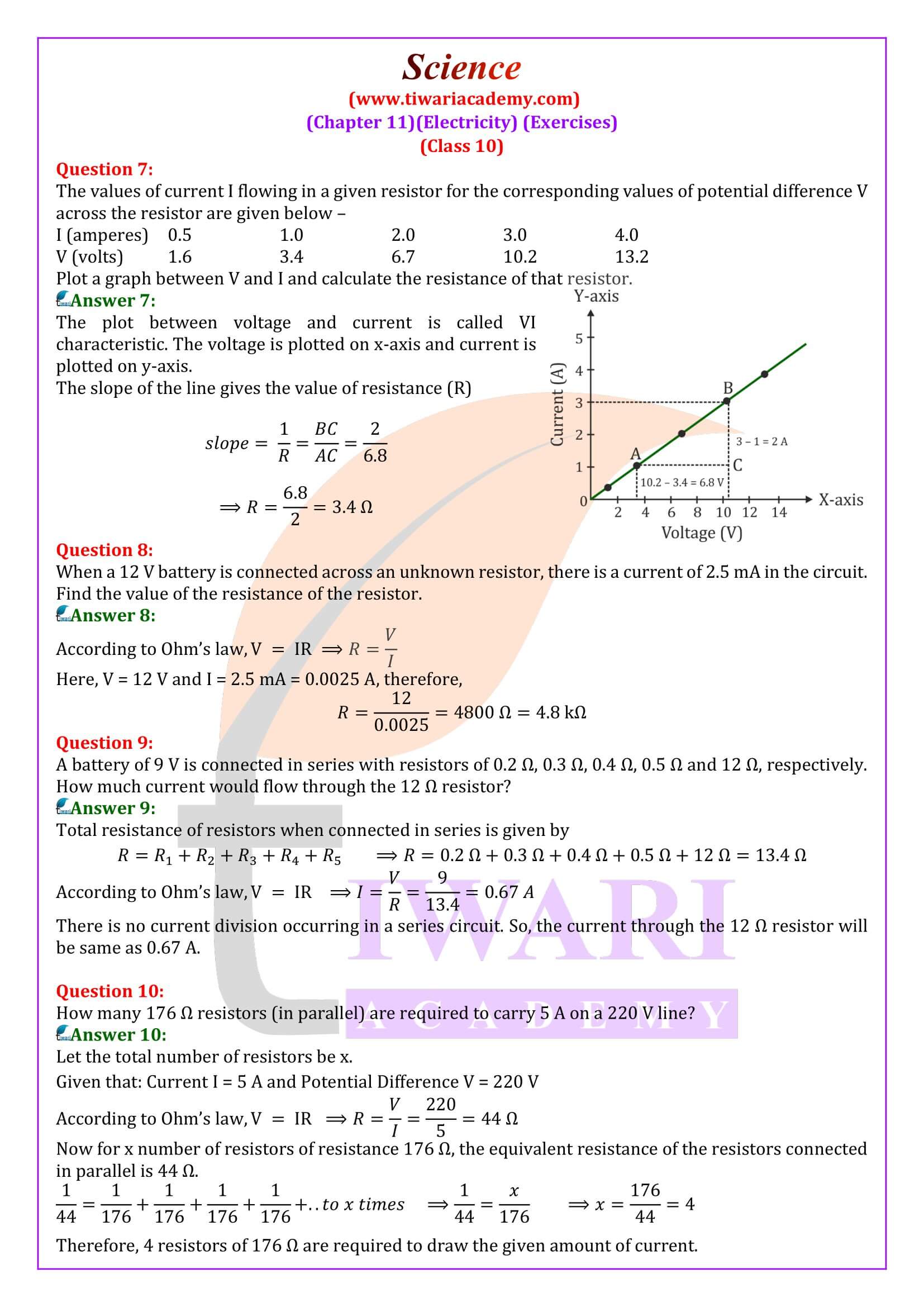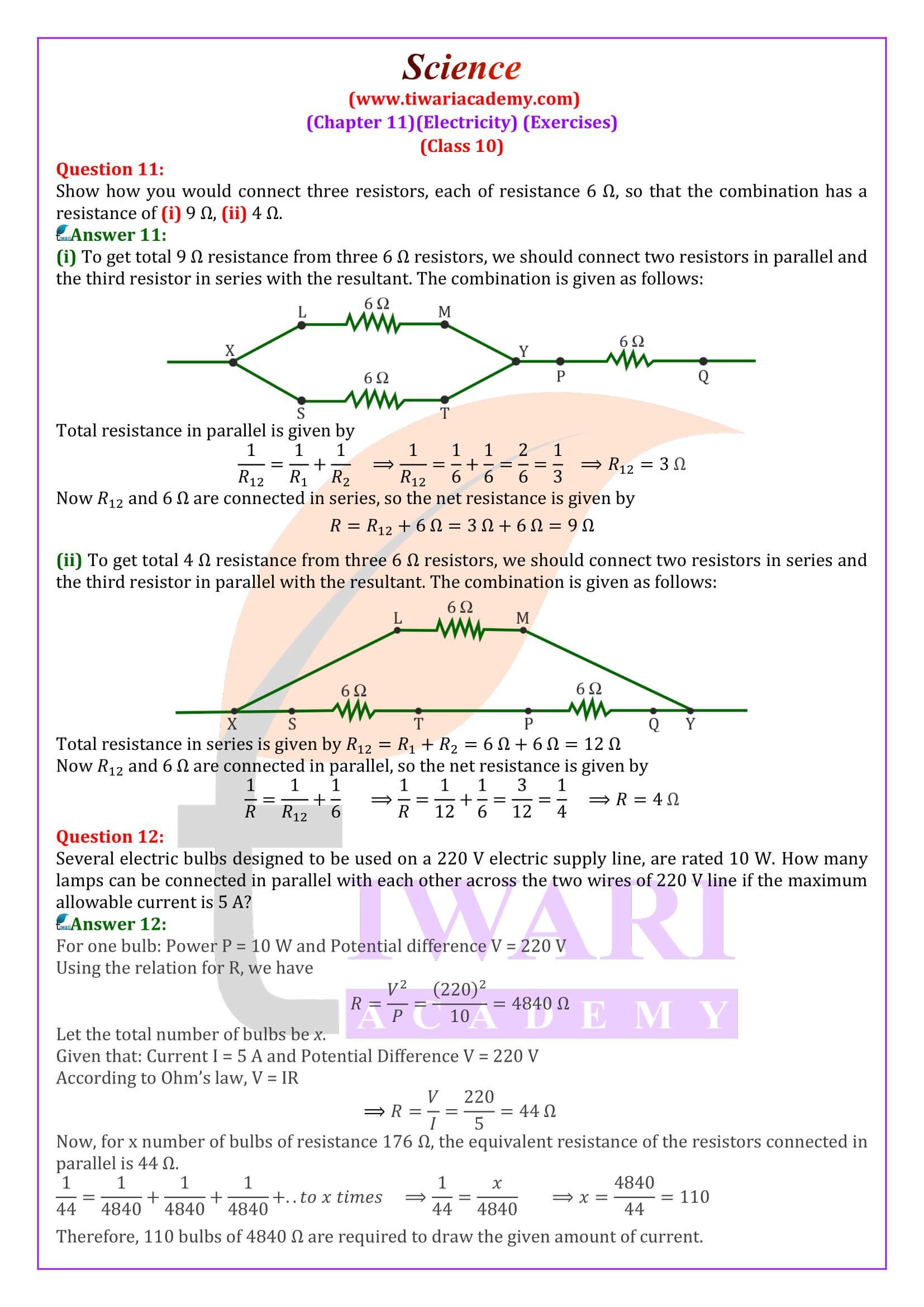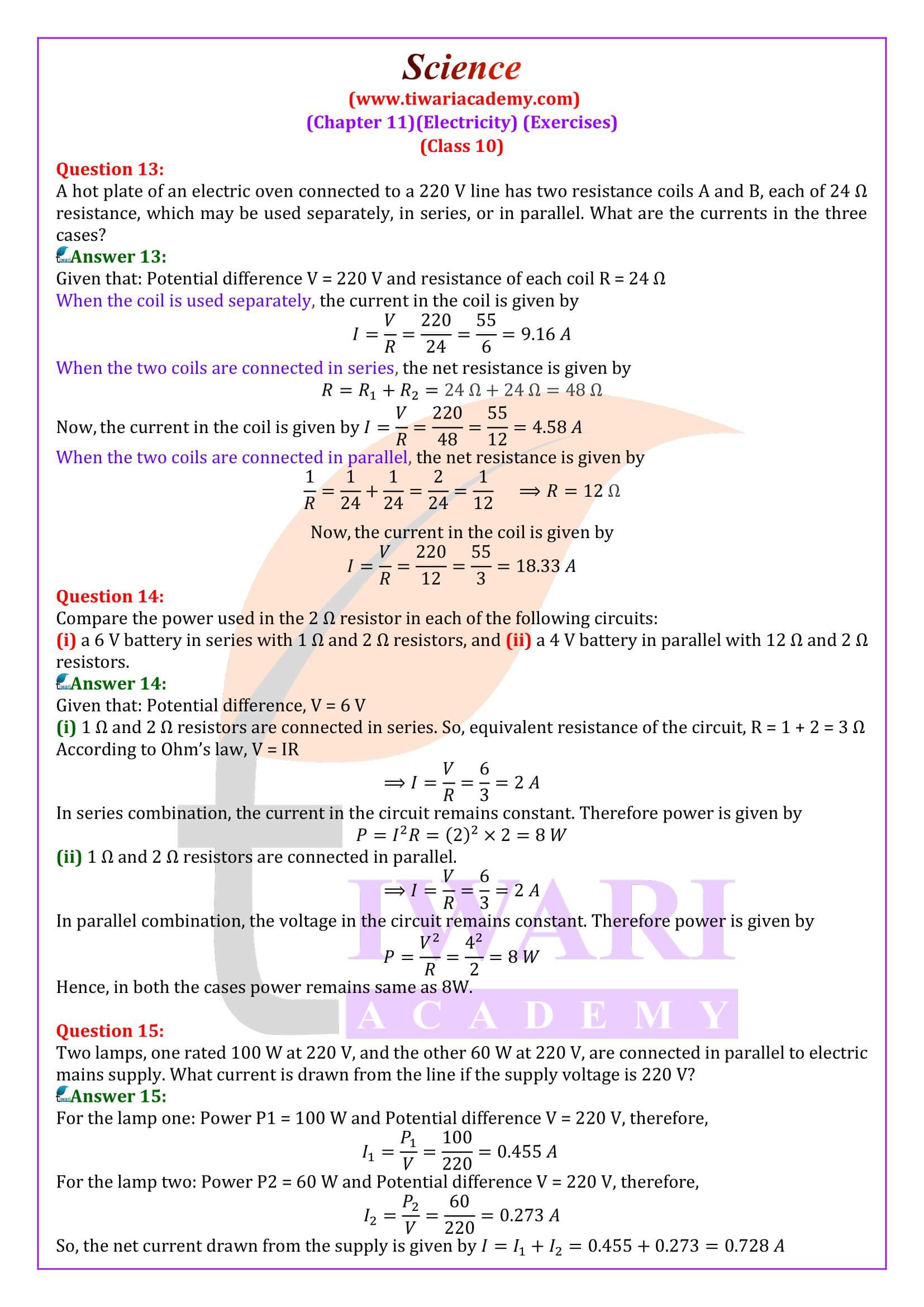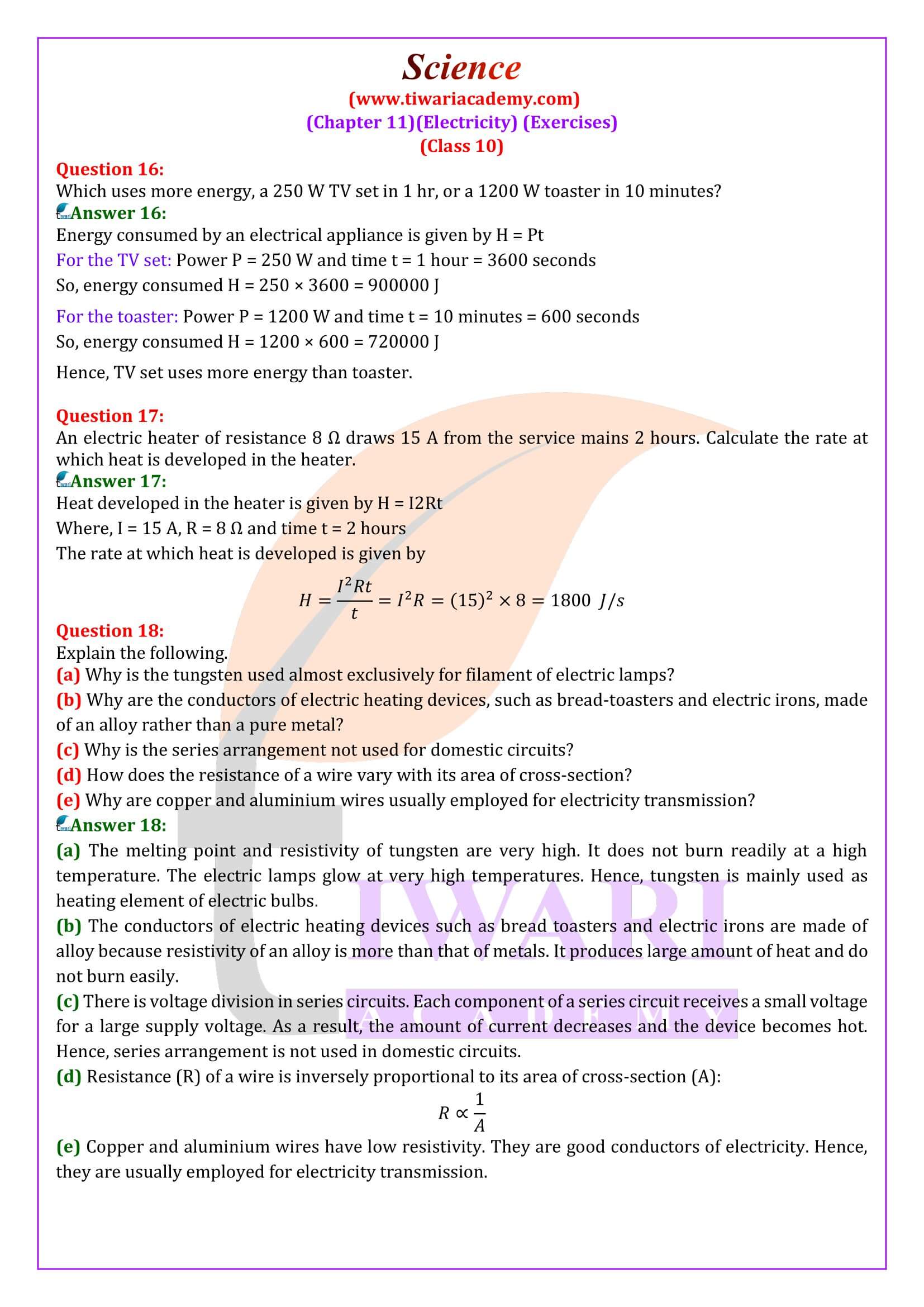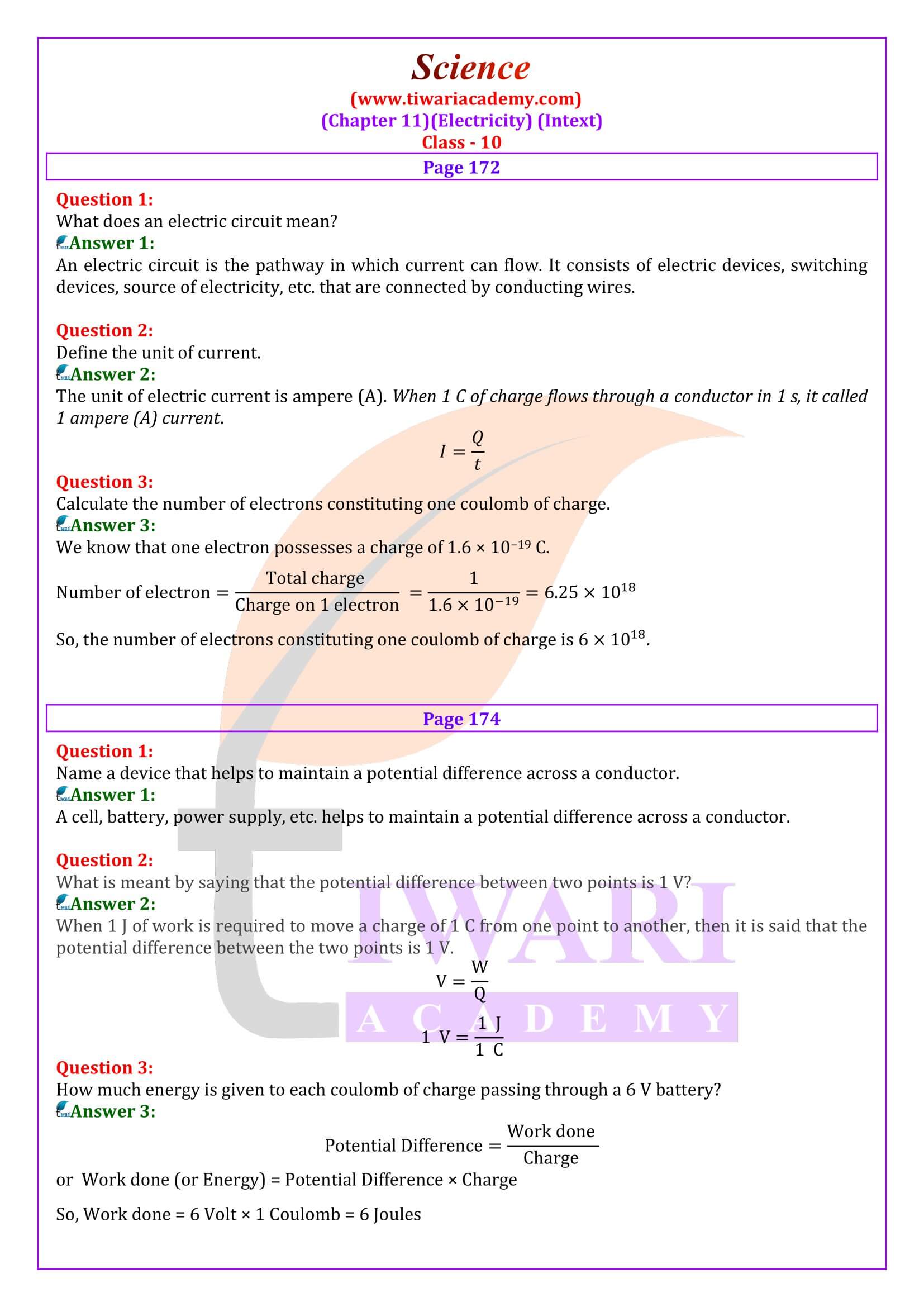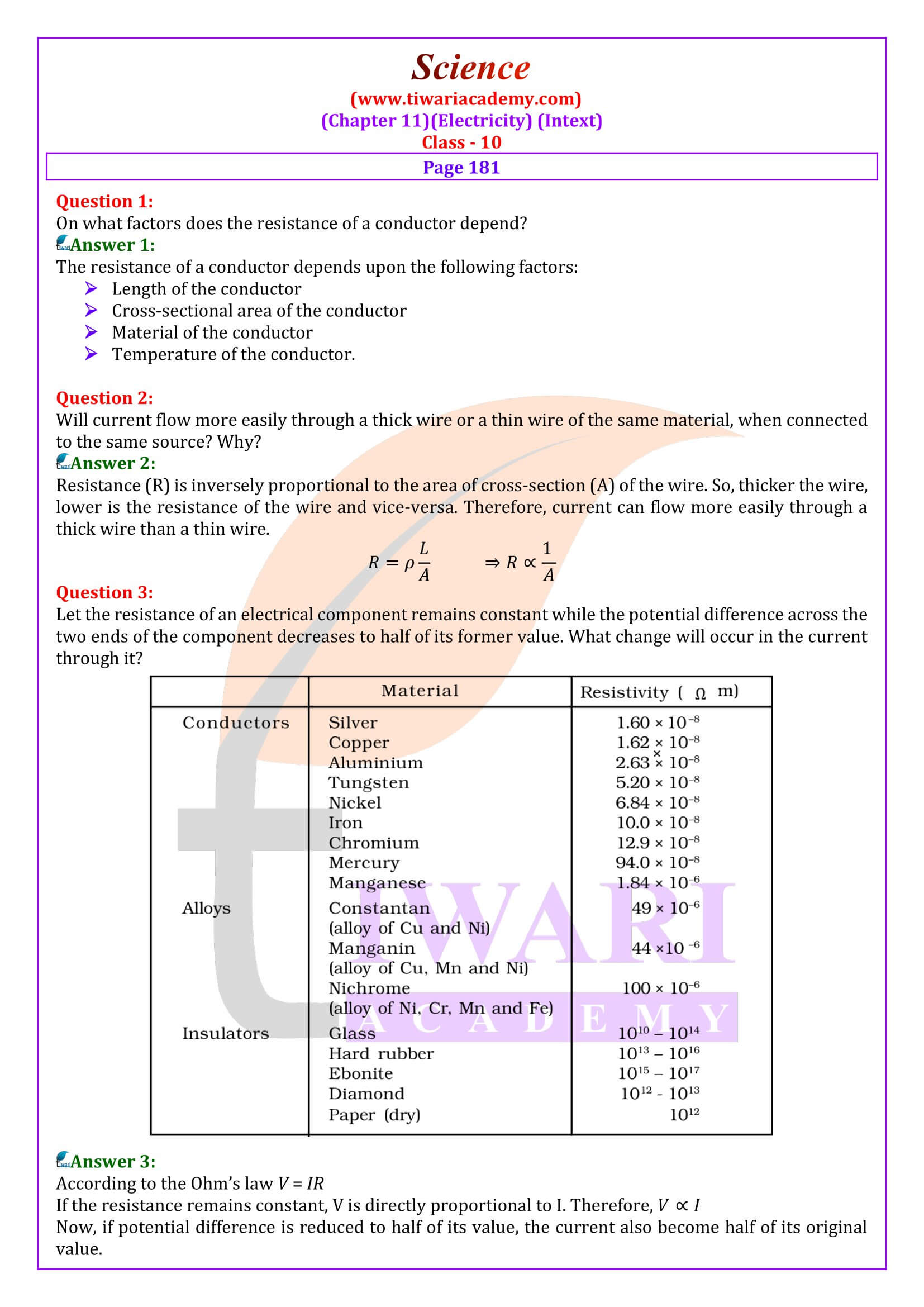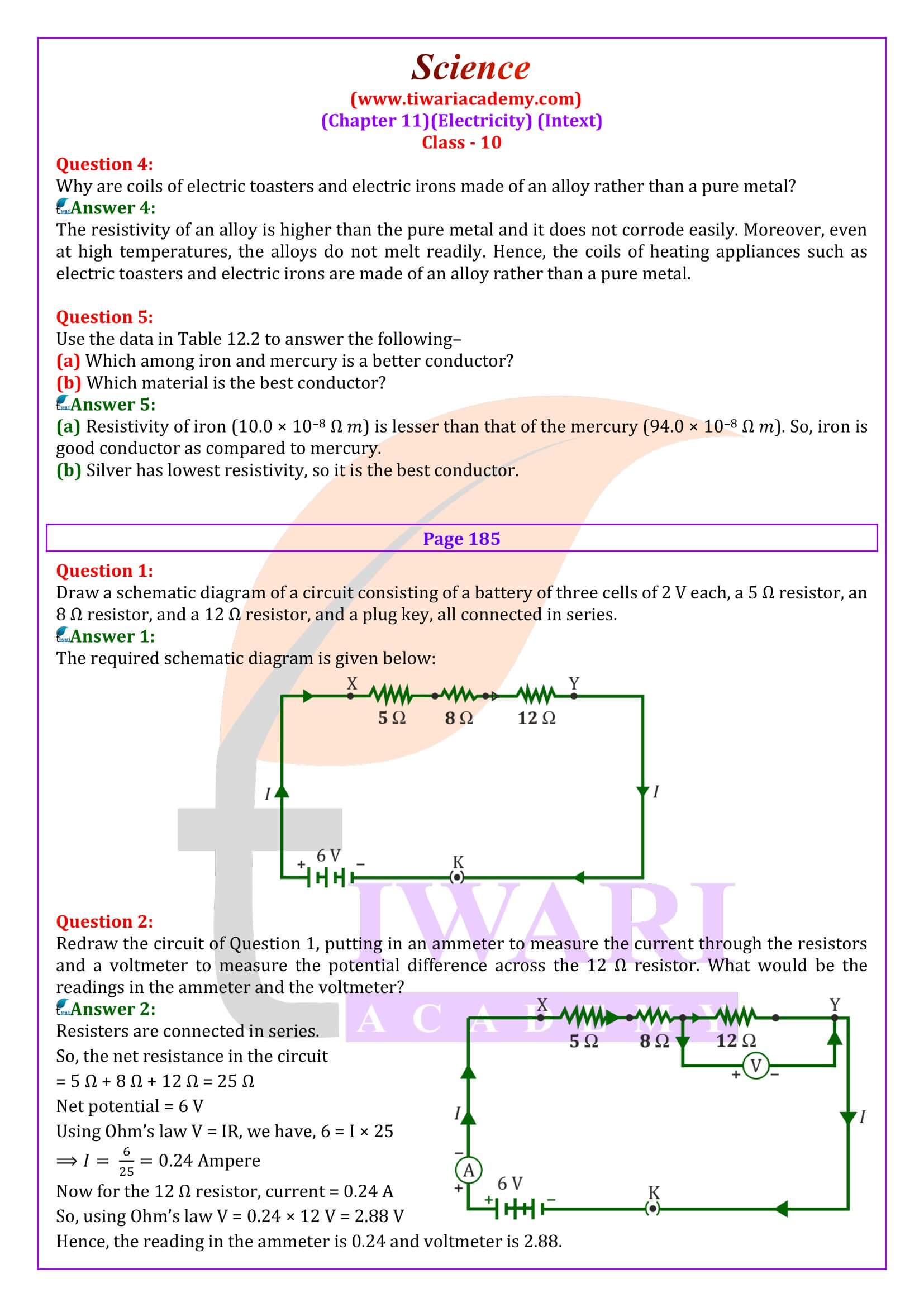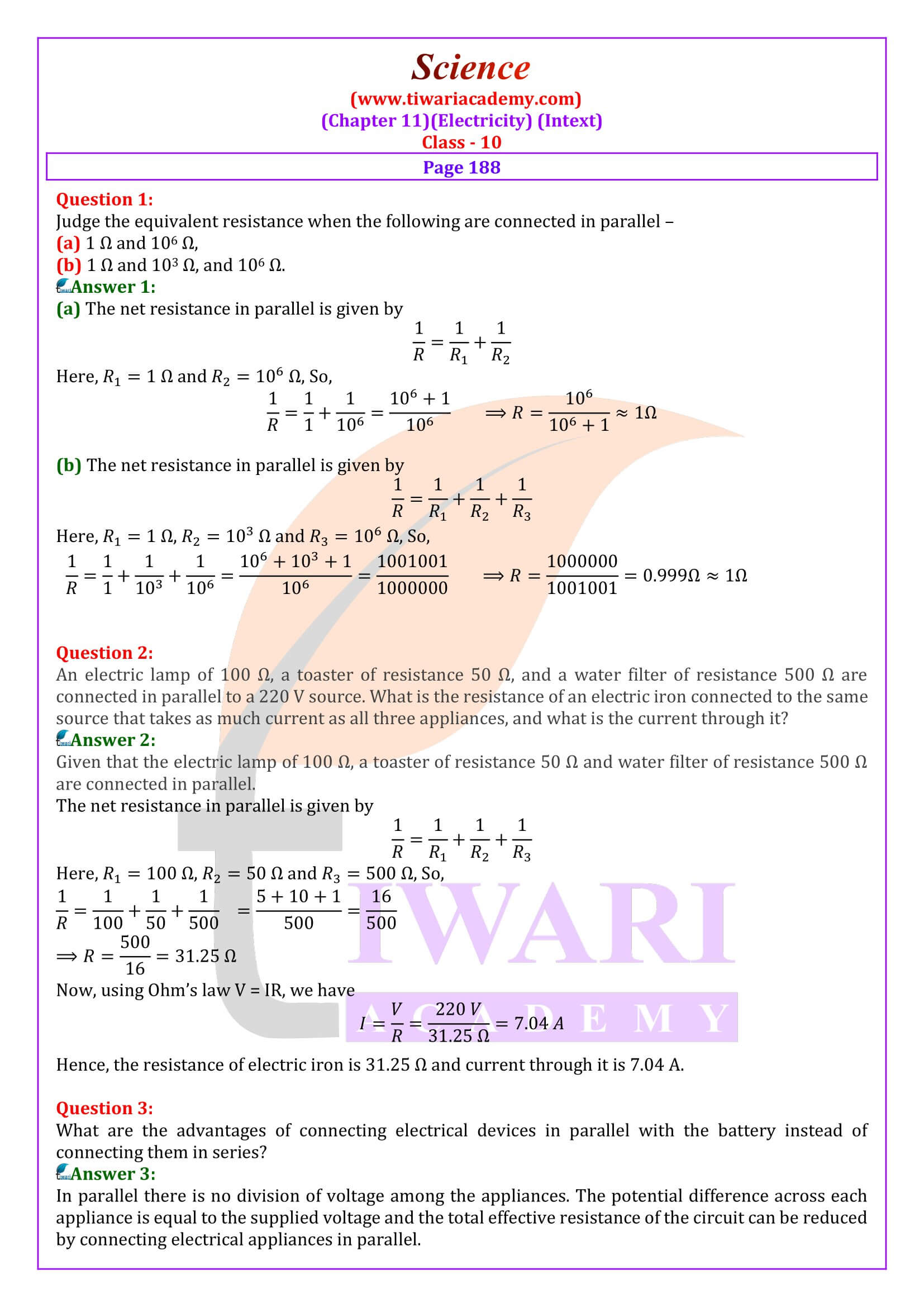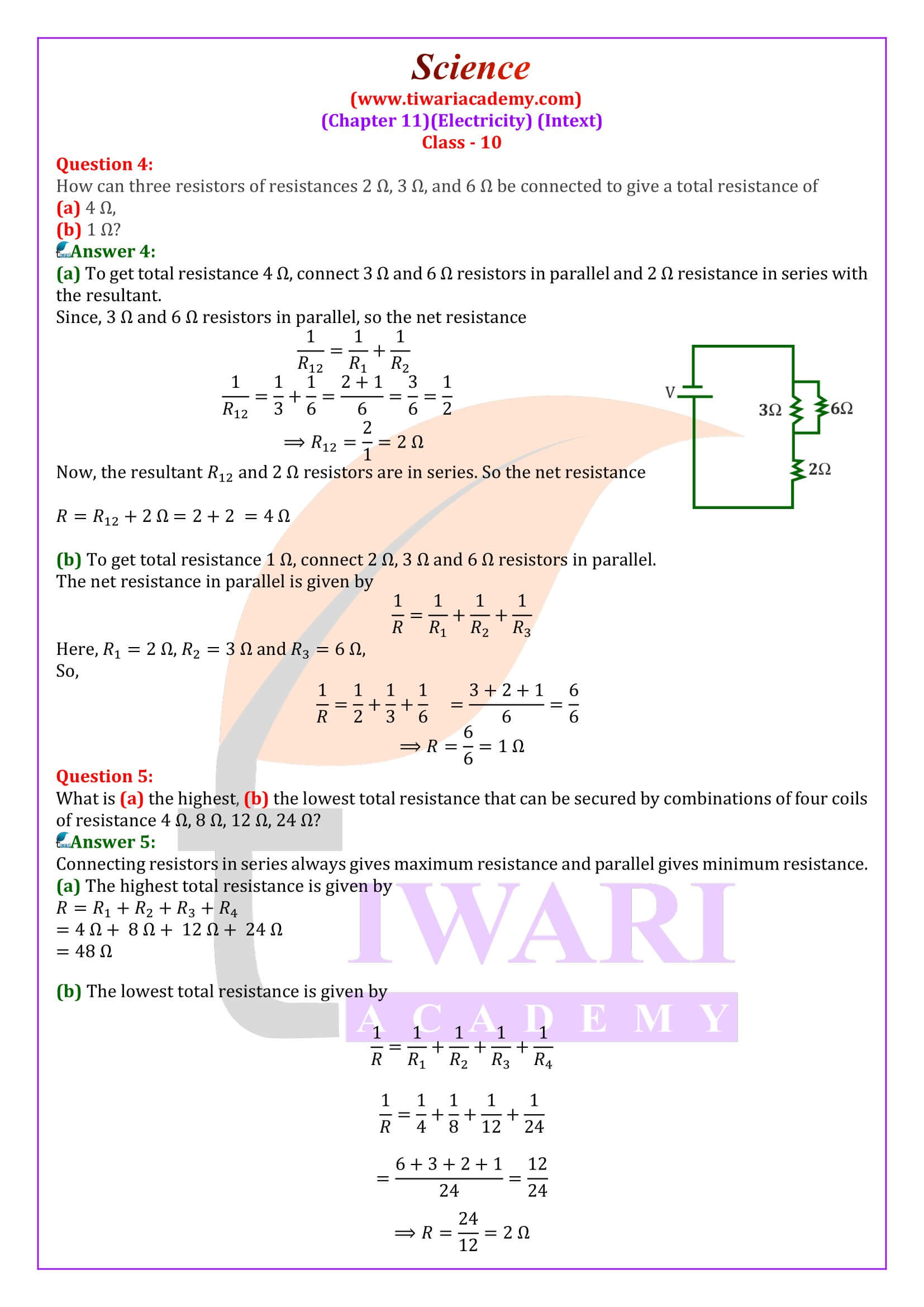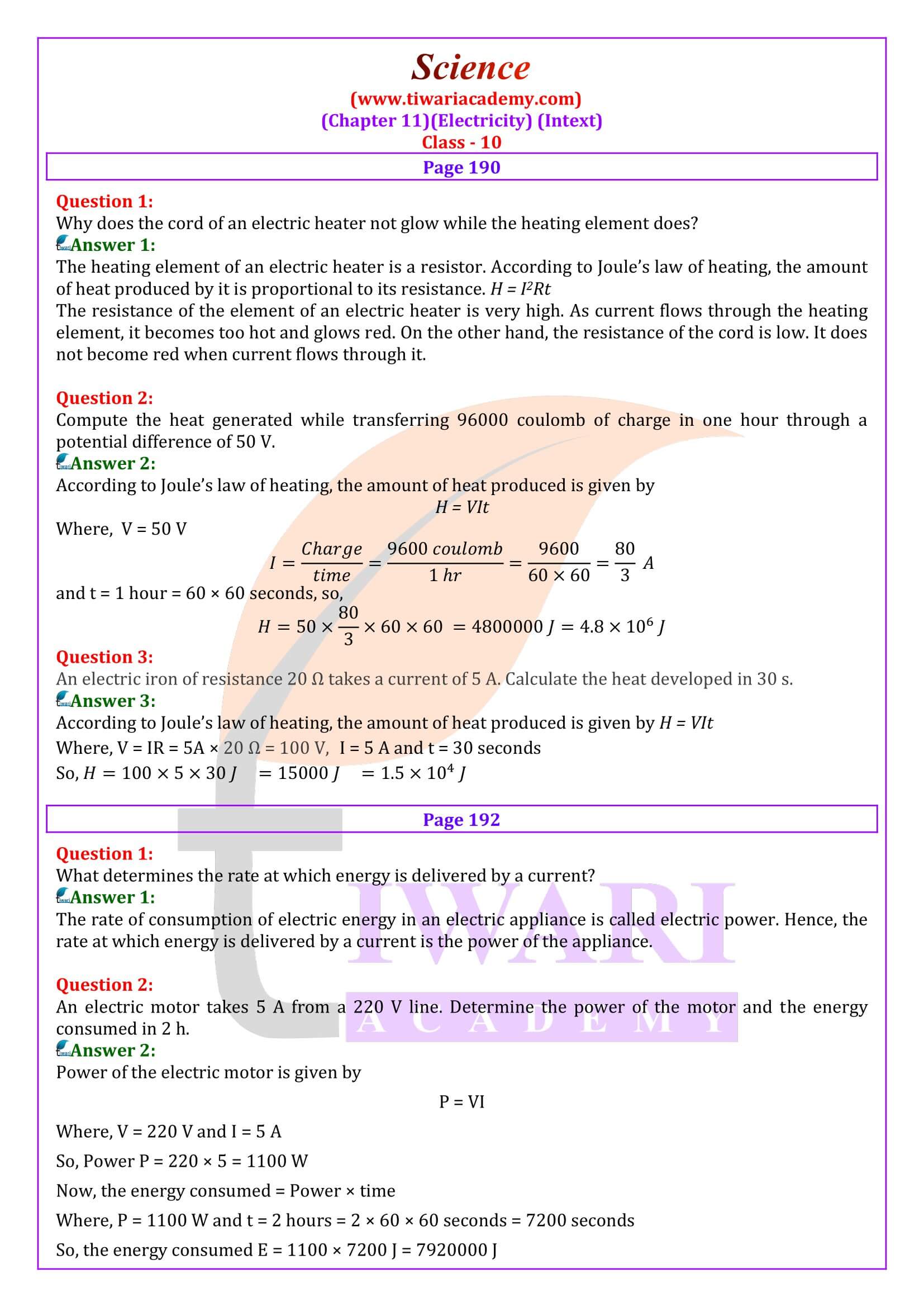Class 10 Science Chapter 11 Solutions
Class 10 Science Chapter 11 Exercises Solutions
Class 10 Science Chapter 11 Intext Exercises
Class 10 Science Chapter 11 in Hindi Medium
Class 10 Science Book Download in PDF
Class 10 Science Chapter 11 Board Questions
Class 10 Science Chapter 11 MCQ
Class 10 Science Chapter 11 Extra Questions
NCERT Solutions for Class 10 Science Chapter 11 Electricity in Hindi and English Medium updated for CBSE 2024-25. Get here the revised question answers of chapter 11 class 10 science based on rationalised syllabus and new textbooks issued for academic session 2024-25.
| Class: 10 | Science |
| Chapter 11: | Electricity |
| Content: | Intext and Exercise Solution |
| Content Type: | PDF, Text and Online Videos |
| Academic Session: | CBSE 2024-25 |
| Medium: | English and Hindi Medium |
Class 10 Science Chapter 11 Answers in Hindi and English Medium
NCERT Class 10 Science Chapter 11 Electricity explores various aspects of electricity, electrical circuits, and their applications. Topics covered in this chapter are; electric current, Introduction to electric current, and its definition. Electric current as the flow of electric charges. Measurement of electric current in amperes (A). Potential difference and voltage, understanding potential difference (voltage) as the driving force for electric current. Measuring potential difference in volts (V). The concept of an electric circuit. Ohm’s law, Introduction to Ohm’s Law, which relates current (I), voltage (V), and resistance (R) in an electric circuit.
The mathematical representation of Ohm’s law
V = IR. Here, R is Resistance. Definition of resistance in an electric circuit, factors affecting resistance, including the length and cross-sectional area of a conductor. The concept of resistivity, and the relationship between length, cross-sectional area, and resistance. The effect of temperature on resistance. Variation of resistance with material. Electric power, understanding electric power and its importance. Calculation of electric power using the formula P = IV. Commercial Unit of Electric Energy, Introduction to the unit of electrical energy, the kilowatt-hour (kWh). Calculating the cost of electrical energy consumption.
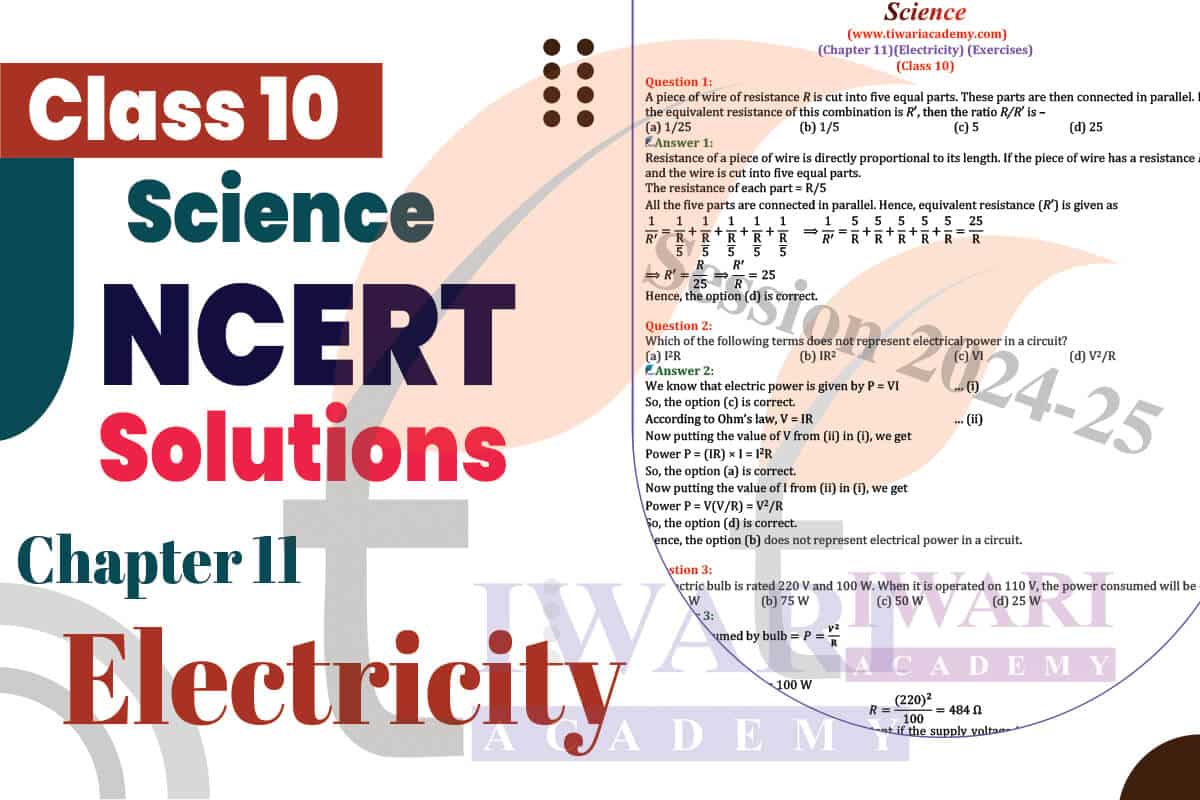
Heating Effects of Electric Current
Explanation of how electric current produces heat in resistors. The concept of the heating effect of electric current applications, such as electric heaters and electric irons. Electric Circuits, Explanation of the components of an electric circuit, cell/battery, switch, and conductors. Understanding the complete and incomplete electric circuits. Series and parallel connections in circuits. Symbols for electric Components, Introduction to symbols used for representing electrical components in circuit diagrams.
NCERT Class 10 Science Chapter 11 Electricity is indeed important from the examination point of view. It covers fundamental concepts in physics and electricity, and a good score in this chapter contributes to your overall performance in the science subject. Therefore, it is advisable to dedicate sufficient time and effort to prepare effectively for this chapter.
Amperes’ Circuital Law
Introduction to Ampere’s Circuital Law and its application to magnetic fields produced by electric currents. Electric power distribution, and overview of electric power distribution systems, including power plants, transformers, and transmission lines. Safety measures in electric circuits, importance of safety measures in handling electrical appliances and circuits. Safety precautions to avoid electrical accidents. These topics provide a fundamental understanding of electricity, circuits, and their practical applications. Understanding this chapter is crucial for building a foundation in electrical concepts and their relevance in our daily lives.
A strong foundation in electricity and electrical circuits is essential for those students who plan to pursue further studies in science and engineering. The chapter emphasizes problem-solving and analytical skills, which are valuable not only for exams but also for developing critical thinking abilities. Some questions require applying the knowledge of electricity to real-world situations or scenarios, testing your ability to connect theoretical knowledge with practical situations.
Preparing for NCERT Class 10 Science Chapter 11 Electricity requires a structured approach and a focus on understanding the fundamental concepts related to electricity and electrical circuits. Pay attention to definitions, explanations, and examples provided. Make concise notes while reading the chapter. Summarize key points, definitions, and formulas. Highlight important terms and concepts. Understand basic concepts, and focus on understanding the fundamental concepts such as electric current, potential difference, resistance, Ohm’s law, and electric power.
Electric Power and Energy
Understanding electric power (P = I.V) and the concept of electrical energy is important. Questions involve calculating power and energy consumption. Safety measures, and knowledge of safety measures when dealing with electrical appliances and circuits is essential. Questions assess your understanding of safety precautions. Real-life applications, and Concepts from this chapter have practical applications in our daily lives. Questions related to the use of electrical appliances, wiring, and power consumption.
NCERT Solutions for Class 10 Science Chapter 11
Class X Science chapter 11 answers of intext questions given on Page 200 or Page 202 or Page 209 or Page 213 or Page 216 or Page 218 or Page 220 or Exercises in Hindi and English Medium. All the solutions are updated for new academic session.
Learn Ohm’s Law and Its Applications
Familiarize yourself with Ohm’s Law (V = IR) and its applications in solving problems related to electric circuits. Practice numerical problems, and work through numerical problems related to Ohm’s law, resistance, and electric power. Pay attention to units and use the appropriate formulas. Study Circuit Diagrams, and learn to interpret and draw simple circuit diagrams. Understand the symbols used for electrical components. Learn about electric power and energy, Study the concept of electric power (P = IV) and the commercial unit of electric energy (kWh). Calculate the cost of electricity consumption.
UP Board students also download UP Board solutions for Class 10 Science chapter 11 in Hindi Medium. 10th Science Chapter 11 answers in Hindi medium are also given free to download. NCERT Solutions Offline Apps are based on latest NCERT Books following the new CBSE Syllabus.
Explore Heating Effects of Electric Current
Understand how electric current produces heat in resistors and its applications, such as electric heaters and irons. Solve the exercise questions and examples given in your textbook. Practice questions related to circuits, resistance, and electrical calculations. Explore series and parallel circuits, and learn the characteristics of series and parallel connections in electric circuits. Solve problems related to the combined resistance of resistors in series and parallel. Ampere’s circuital law, understand the concept of Ampere’s circuital law and its application to magnetic fields produced by electric currents.
Learn about safety measures in handling electrical appliances and circuits. Understand the importance of safety precautions to avoid electrical accidents. Use visual aids and diagrams, and visualize electric circuits and concepts by drawing diagrams and using visual aids. Diagrams can help you understand complex circuit configurations. Solve previous years’ board exam questions related to this chapter to get a sense of the commonly asked questions.
Questions related to Ohm’s law, resistance, electric power, and calculations involving electrical circuits are commonly included in board exams. Numerical problem-solving skills are crucial for this chapter. Electric circuits, and understanding the components of an electric circuit, series, and parallel connections, and how circuits work is an important aspect of this chapter. Questions often assess your ability to analyze and draw circuit diagrams. Ohm’s law (V = IR) is a fundamental equation in electricity. Questions related to Ohm’s law and its applications in solving problems are commonly asked.
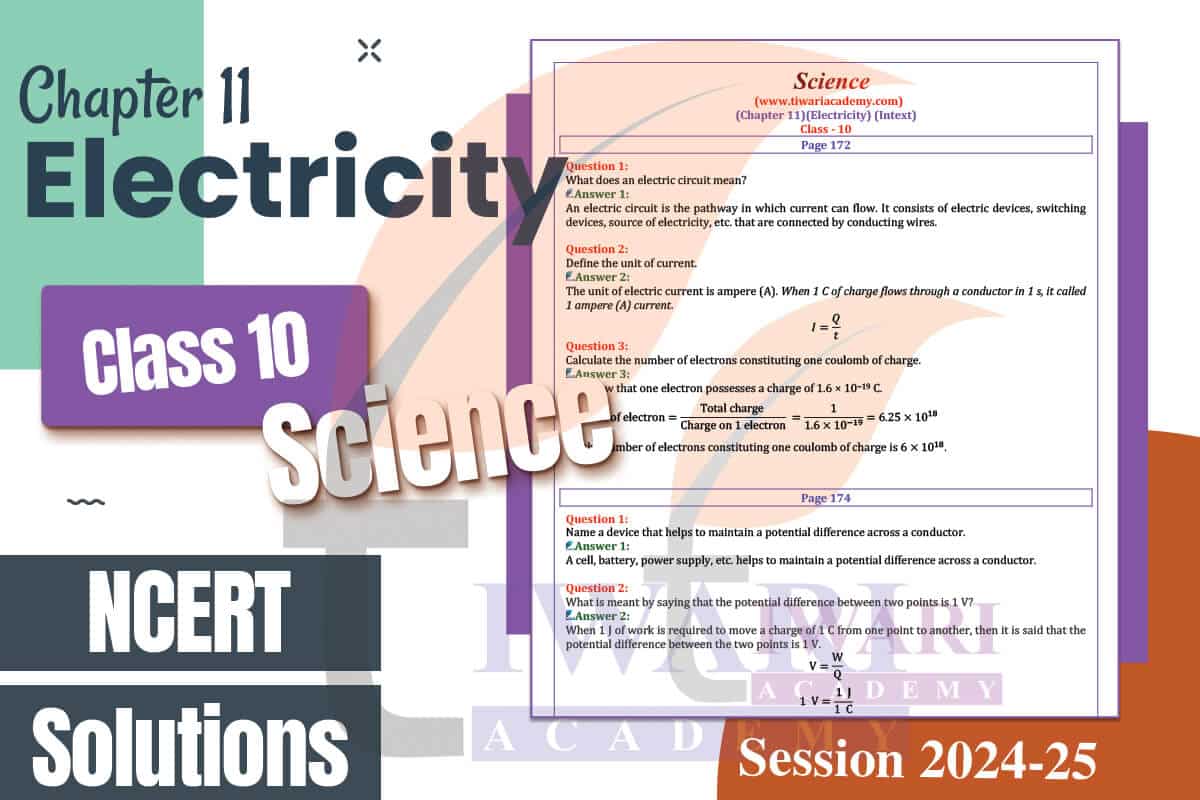
Regular revision is essential. Dedicate time to revise your notes, diagrams, and important concepts from the chapter. If you have any doubts or find certain concepts challenging, don’t hesitate to seek help from your teacher or classmates. Maintain a positive attitude and stay confident in understanding and applying the concepts. By following these steps and deeply understanding the concepts, you can prepare effectively for NCERT Class 10 Science Chapter 11 Electricity. Practice is key to mastering numerical problems, and visualization through diagrams can aid in grasping circuit configurations.
NCERT Class 10 Science Chapter 11 Electricity is of significant importance from the examination point of view for several reasons. Chapter 11 of 10th science covers fundamental concepts related to electricity, electrical circuits, and their applications. A strong grasp of these concepts is essential for understanding more advanced topics in physics.
Class 10 Science Chapter 11 Extra Question Answer
What is meant by resistance of a conductor?
Resistance: The resistance of a conductor is its property by virtue of which it opposes the flow of current through it. It is equal to the ratio of the potential difference applied across the conductor to the current flowing through it.
Resistance = Potential difference / Current Or R = V/I.
What is an electric circuit? Distinguish between an open and a closed circuit.
A closed and continuous path along which an electric current flows is called an electric circuit.
In a torch, a switch provides a conducting link between a battery (a number of cells placed in proper order) and a bulb. When the switch is turned ON, an electric current flow through the bulb and its gives light. Such a continuous and closed path on an electric current is called an electric circuit. When the circuit is broken anywhere (or switch is turned OFF), the current stops flowing ant the bulb does not glow. An electric circuit through which no current flows is called an open circuit. An electric circuit through which current flows continuously is called a closed circuit.
What is meant by potential difference between two points? What is the SI unit of potential difference?
Potential difference: The potential difference between two points in an electric field is the amount of work done in bringing a unit positive charge from one point to the other.
V = W/Q or Potential difference = Work done / Charge
The SI unit of potential difference is joule/coulomb or volt.
Give four reasons why nichrome element is commonly used in household appliances.
In most of the household heating appliance, nichrome element is used because of the following reasons:
(i) Its melting point is high.
(ii) Its resistivity is large.
(iii) It can be easily drawn into thin wire.
(iv) It is not easily oxidised by the oxygen of the air when heated.
10th Science Chapter 11 Answers in English & Hindi Medium
NCERT Solutions for Class 10 Science Chapter 11 Electricity all question answers, whether intext or exercises questions. All are updated as per student’s suggestions for 2024-25. Download NCERT Solutions as well as Offline Apps for other subjects also. Offline Apps are such that once downloaded, no need of internet later on.
Tiwari Academy is an online educational platform that assists students in their preparation for NCERT Class 10 Science Chapter 11 Electricity and other subjects as well. Here’s how Tiwari Academy can be helpful. Tiwari Academy provides detailed solutions to the exercises and questions found in the NCERT textbook. This helps students understand the correct way to solve problems and verify their answers. It offers supplementary practice questions that allow students to further practice and reinforce their understanding of the chapter.
Tiwari Academy provides comprehensive explanatory notes and study materials that simplify complex concepts. These materials are beneficial for students who need additional explanations and examples. It offers video tutorials on various topics. These videos help students visualize and understand challenging concepts more effectively. Tiwari Academy website includes interactive simulations and animations related to the concepts in Chapter 11. These tools make learning more engaging and help students grasp abstract ideas.
Tiwari Academy is accessible online, making it convenient for students to study and practice at their own pace from anywhere with an internet connection. Overall, it is a useful supplementary resource for students preparing for NCERT Class 10 Science Chapter 11 Electricity. It provides additional practice, explanations, and interactive tools to support their learning and help them perform well in their exams.
Questions 10th Science Chapter 11 for Practice
Question 1:
State Ohm’s law and write the condition in which this law is obeyed?
Answer 1:
This law states that the current (I) flowing through a conductor is directly proportional to the potential difference (V) applied across its ends, provided the temperature and other physical condition remain unchanged.
Mathematically, V ∝ I or V = RI
The proportionality constant R is called the resistance of the conductor.
Question 2:
What is an ammeter? How is it connected in a circuit?
Answer 2:
Ammeter: An ammeter (ampere + meter) is a device used to measure electric current in a circuit. An ammeter is always connected in series in a circuit, so that entire current, which we wish to measure, flows through it.
Important Questions on 10th Science Chapter 11
How is a voltmeter connected in the circuit to measure the potential difference between two points?
To measure the potential difference, a voltmeter should be connected in parallel.
A battery of 9 V is connected in series with resistors of 0.2 Ω, 0.3 Ω, 0.4 Ω, 0.5 Ω and 12 Ω, respectively. How much current would flow through the 12 Ω resistor?
Total resistance of resistors when connected in series is given by R = R1 + R2 + R3 + R4 + R5 = ⟹ R= 0.2 Ω + 0.3 Ω + 0.4 Ω + 0.5 Ω + 12 Ω =13.4 Ω According to Ohm’s law, V = IR I = V/R = 9/13.4 = 0.67 A There is no current division occurring in a series circuit. So, the current through the 12 Ω resistor will be same as 0.67 A.
Which uses more energy, a 250 W TV set in 1 hr, or a 1200 W toaster in 10 minutes?
Energy consumed by an electrical appliance is given by H = Pt For the TV set: Power W = 250 W and time t = 1 hour = 3600 seconds So, energy consumed H = 250 × 3600 = 900000 J For the toaster: Power W = 1200 W and time t = 10 minutes = 600 seconds So, energy consumed H = 1200 × 600 = 720000 J Hence, TV set uses more energy than toaster.
Why is the tungsten used almost exclusively for filament of electric lamps?
The melting point and resistivity of tungsten are very high. It does not burn readily at a high temperature. The electric lamps glow at very high temperatures. Hence, tungsten is mainly used as heating element of electric bulbs.
Why are the conductors of electric heating devices, such as bread-toasters and electric irons, made of an alloy rather than a pure metal?
The conductors of electric heating devices such as bread toasters and electric irons are made of alloy because resistivity of an alloy is more than that of metals. It produces large amount of heat and do not burn easily.
Why is the series arrangement not used for domestic circuits?
There is voltage division in series circuits. Each component of a series circuit receives a small voltage for a large supply voltage. As a result, the amount of current decreases and the device becomes hot. Hence, series arrangement is not used in domestic circuits.
Why are copper and aluminium wires usually employed for electricity transmission?
Copper and aluminium wires have low resistivity. They are good conductors of electricity. Hence, they are usually employed for electricity transmission.
What does an electric circuit mean?
An electric circuit is the pathway in which current can flow. It consists of electric devices, switching devices, source of electricity, etc. that are connected by conducting wires.
Name a device that helps to maintain a potential difference across a conductor.
A cell, battery, power supply, etc. helps to maintain a potential difference across a conductor.
What is meant by saying that the potential difference between two points is 1 V?
When 1 J of work is required to move a charge of 1 C from one point to another, then it is said that the potential difference between the two points is 1 V. V = W/Q 1 V = 1 j / 1 C
On what factors does the resistance of a conductor depend?
The resistance of a conductor depends upon the following factors: Length of the conductor Cross-sectional area of the conductor Material of the conductor Temperature of the conductor.
Why are coils of electric toasters and electric irons made of an alloy rather than a pure metal?
The resistivity of an alloy is higher than the pure metal and it does not corrode easily. Moreover, even at high temperatures, the alloys do not melt readily. Hence, the coils of heating appliances such as electric toasters and electric irons are made of an alloy rather than a pure metal.
What are the advantages of connecting electrical devices in parallel with the battery instead of connecting them in series?
In parallel there is no division of voltage among the appliances. The potential difference across each appliance is equal to the supplied voltage and the total effective resistance of the circuit can be reduced by connecting electrical appliances in parallel.
Why does the cord of an electric heater not glow while the heating element does?
The heating element of an electric heater is a resistor. According to Joule’s law of heating, the amount of heat produced by it is proportional to its resistance. H = I^2 Rt The resistance of the element of an electric heater is very high. As current flows through the heating element, it becomes too hot and glows red. On the other hand, the resistance of the cord is low. It does not become red when current flows through it.
What determines the rate at which energy is delivered by a current?
The rate of consumption of electric energy in an electric appliance is called electric power. Hence, the rate at which energy is delivered by a current is the power of the appliance.
Questions from Board Papers
Question 1:
Distinguish between conventional current and electronic current. Or In an electric circuit state the relationship between the direction of conventional current and the direction of flow of electrons.
Answer 1:
conventional current and electronic current: When a conductor AB is connected across the terminals of a cell , free electrons begin to drift or move from its end B (connected to the negative terminal of the cell) to the end A (connected to the positive terminal of the cell). The current constituted by flowing electrons is called electronic current. Clearly, the direction of electronic current is from negative terminal to positive terminal.
By convention, the direction of motion of positive charges is taken as the direction of electric current. It is from positive terminal to negative terminal. As the electrons are negatively charged, the direction of conventional current is an electric circuit is taken as opposite to the direction of the flow of electrons.
Question 2:
Why does the cord of an electric heater not glow while the heating element does?
Answer 2:
Both the cord and the heating element of an electric heater carry the same current. But the heating element becomes hot due to its high resistance (H=I²Rt) and begins to glow. The cord remains cold due to its low resistance and dos not glow.
What are the important examples in chapter 11 of class 10th Science?
Yes, there are 13 examples in chapter 11 of class 10th Science. All examples (numerical) are significant for the exams. Students should practice all 13 examples of this chapter. These examples are good and easy.
How much time, students require to prepare chapter 11 of Class 10th Science Book?
Students require 15-20 days to prepare chapter 11 of grade 10th Science if they give 2 hours per day to chapter 11. This time depends on many things like student’s working speed, capability, etc.
What is the core motive of chapter 11 (Electricity) of 10th standard Science?
The core motive of chapter 11 (Electricity) of 10th standard Science is to teach students the following things:
- 1. Electric current and circuit
- 2. Electric potential and potential difference
- 3. Circuit diagram
- 4. Ohm’s law
- 5. Factors on which the resistance of a conductor depends
- 6. Resistance of a system of resistors
- 7. Resistors in series
- 8. Resistors in parallel
- 9. Heating effect of electric current
- 10. Practical applications of heating effect of electric current
- 11. Electric power
Is chapter 11 of class 10th Science complex to understand?
Chapter 11 of class 10th Science is not easy and not complex. It lies in the mid of easy and hard because some part of this chapter is easy, and some are complicated. However, the difficulty level of any chapter varies from child to child. So, chapter 11 of class 10th Science is easy, or tough depends on children also. Some children find it hard, some find it easy, and some find it in the middle of easy and hard.
